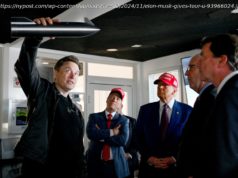BEIJING (AP) — A list of hard-line demands that the Trump administration handed China this week could make it even more difficult to resolve…
BEIJING (AP) — A list of hard-line demands that the Trump administration handed China this week could make it even more difficult to resolve a trade conflict between the world’s two largest economies.
That’s the view of trade analysts who say the U. S. insistence that Beijing shrink America’s gaping trade deficit with China by a hefty $200 billion by the end of 2020, among other demands, are more likely to raise tensions than to calm them.
A U. S. official confirmed the authenticity of a document outlining U. S. priorities that was presented to China ahead of two days of trade talks that ended Friday. The official spoke on condition of anonymity because of the confidential nature of the talks.
In Washington on Friday, President Donald Trump said, „We have to bring fairness in trade between the U. S. and China, and we will do that.“
Earlier, Trump had said he wanted Beijing to cut by $100 billion the chronic U. S. trade deficit in goods, which Washington says stood at a record $375.2 billion last year.
After the talks ended, China’s Commerce Ministry said the two sides had agreed to establish a mechanism to try to work through their dispute, though differences remained, Chinese state media reported. The report did not give specifics, suggesting that little progress had been achieved.
The U. S. document is described, in an introductory disclaimer, as being provided to the Chinese ahead of the visit to Beijing by Treasury Secretary Steven Mnuchin and other U. S. officials.
It included demands that China immediately stop providing subsidies to industries listed in a key industrial plan. China must end some of its policies related to technology transfers, a key source of tension underlying the dispute, the list also says.
The U. S. wants China not to retaliate against U. S. measures currently being pursued against it. For instance, the U. S. says China should agree not to target U. S. farmers or agricultural products and „not oppose, challenge or otherwise retaliate“ when the U. S. moves to restrict Chinese investment in the U. S. in sensitive sectors.
American analysts were struck by the aggressiveness of the Trump team’s demands. Eswar Prasad, a professor of trade policy at Cornell University, said the hard-nosed approach „makes it harder to envision a path toward a negotiated settlement.“
Prasad said the Chinese are open to negotiations on opening their market wider and doing a better job of protecting intellectual property. „Beijing is clearly in no mood, however, to meet the U. S. team’s expectation of capitulation in the face of threats of tariffs and other trade sanctions,“ he said.
Analysts said the Chinese were likely to view the confrontational posture struck by the U. S. as unreasonable and akin to bullying, potentially making it difficult to tone down friction over such issues.
Yu Miaojie, a professor at Peking University’s National School of Development, described some of the demands as „like lions opening their mouths.“
„When it comes to negotiations, both sides can provide a list of requests and we will seek common ground while reserving our differences,“ Yu said. „If one side provides a list with unreasonable requests, the Chinese government is unable to accept it.“
The list was widely circulated on Chinese social media platforms Friday, drawing hundreds of comments from Chinese internet users criticizing the U. S.
„China won’t be frightened by this kind of threat,“ wrote Hu Xijin, the chief editor of the Global Times, a nationalistic tabloid affiliated with the Communist Party mouthpiece, in a post on the Sina Weibo website. Hu said he believed China would engage in talks seriously but also be fully prepared for them to fail.
„China will never trade off its core interests,“ Hu wrote.
Still, the list was welcomed by a U. S. business group which has lobbied the Trump administration for greater clarity on what it wanted China to do. Some groups had complained the administration was sending mixed messages.
„We’ve been saying that the Trump administration needs to define success and what specific outcomes it is seeking,“ said Jake Parker, vice president for China of the U. S.-China Business Council. The list submitted to China helps „lead to a solution and avoid tariffs and other sanctions,“ he said.
China’s Commerce Ministry did not respond to a request for comment on the U. S. demands and did not refer to them in the remarks released by state media Friday.
The two sides „reached consensus in some areas,“ the official Xinhua News Agency said.
„Both sides realized that there are still relatively big differences over some issues and that they need to continue to work hard to make more improvements,“ the report said.
It said the discussions included expanding U. S. exports to China, trade in services, the protection of intellectual property rights and how to resolve the use of tariffs and non-tariff measures.
There was no immediate comment from the U. S. delegation. A motorcade was seen leaving the U. S. Embassy in Beijing on Friday afternoon and the group departed China later in the day.
The list of U. S. demands was first reported by The Wall Street Journal on Friday.
Earlier Friday, Mnuchin sounded a positive note about the two days of talks, saying at a Beijing hotel on his way to talks that they were having „very good conversations.“
The group led by Mnuchin included Commerce Secretary Wilbur Ross, U. S. Trade Representative Robert Lighthizer and White House trade advisor Peter Navarro, a fierce China critic. But the officials are seen as holding conflicting views on how to resolve the dispute. That could have undermined their ability to negotiate with the Chinese.
His administration has threatened to impose new tariffs on roughly $150 billion in Chinese goods. China in turn announced plans for its own tariffs on U. S. goods.
It was unclear if the talks had cleared the air enough to stave off such potentially damaging moves and alleviate uncertainty for investors and businesses likely to be affected by such measures.
The dispute will be tough to resolve because the fundamental issue is that the U. S. wants to stop China from moving up the so-called value chain as it transforms into an advanced economy, said Louis Kuijs, head Asia economist at Oxford Economics. But „there’s no way that China’s going to change its strategy on that.






